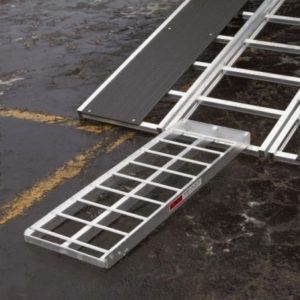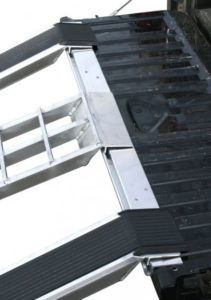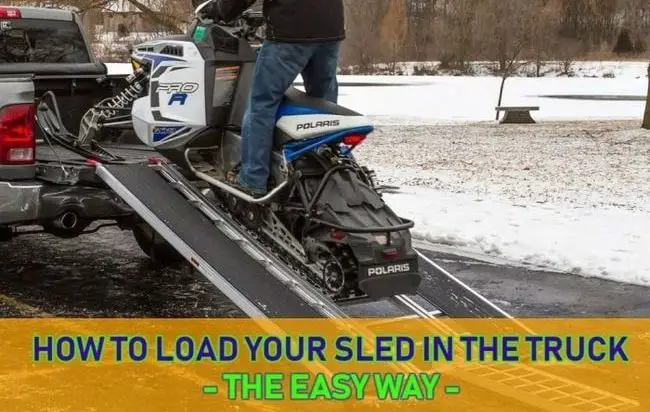Every rider with a truck had this question at the beginning of his snowmobiling career: how to load the snowmobile into a truck? Riding the trail safely, having the most fun one can, and returning home with your body and sled in one piece is the living dream of every snowmobile rider out there. However, just like a truck driver, you will have to make sure that the sled you are carrying from point A to point B will reach the area where you are going to use safe and secured.
Which is why I am here today, namely to properly teach you how to load up your snowmobile into a truck.
Transportation, in concept, is a matter as simple as it can be. You load the sled, your transport it and then you unload it. Easy peasy. However, it is not this that hinders most would be riders, but the means to ensure proper transportation.
Choosing the right ramps
In hindsight, loading the sled into the back of a vehicle is as simple as it gets. And it is. Loading your sled into the back of a truck is a very similar process to that of loading an A.T.V. However, this is where the similarities end. Where the A.T.V. has four wheels, allowing it to be easily loaded by even using two sturdy planks of wood, the snowmobile is a very picky monster on its own.

Best snowmobile load ramp
Due to its triangular design – two lateral, frontal ski-blades and the backside motorized track –, it will require a special type of ramp. This is where many riders are put down by the steep prices, as it can usually start at 200$ and reach a price point of over 400$. One of the best ramps for a snowmobile you can find is this one. You can see it has a “fair” price, but you will have it pretty much forever.
But those 400$ won’t go away too soon and moreover, will make sure that you will not incur any damages while using other, more notorious improvised techniques for loading the sled.
Here are some good ramps (from Amazon.com):
Choose good ramps
Proper snowmobile ramps are made from sturdy steel and with a powerful, yet simple design. They will last you many years of continuous use. However, if you can, consider investing in a ramp extension. They are useful because they provide a sturdy foundation for the track to grip from start, even before the skis touch the ramp.
This is crucial if you are intending to load the sled from a very slippery position or from concrete, the track could start spinning as you throttle up. And due to the fact that it is made for snow and, to a limited extent, water, it could simply launch your sled into the rear of your truck. Ouch!
However, this is not the end of the world. Specialized ramps are the way to go if you have the money necessary and/or the desire to make sure there are no risks involved. Due to a lack of money, many riders opt to simply trust their guts and pray that there is a God out there smiling upon them.
Improvised tricks
Well, over the years, said riders have become accustomed to a few improvised tricks, such as:
- The ”triple plank”: it functions by the same principle the special steel one does; namely, three sturdy planks of wood placed in such a fashion as to load it like an A.T.V. The difference is that it is much cheaper, but also much more dangerous.
Be warned, however, the snowmobile is a heavy monster with expensive components and having it damaged before riding would be quite silly. It is mainly a risk that many are willing to take in order to save money.
Why are steel ramps expensive?
Plus, the main reason steel ramps are so expensive is because they are specifically made to offer the track the grip it requires to advance on the incline, while also offering ski guides (made from rubber for extra efficiency) for the skis to easily slide up.
A wooden plank or a clean steel surface will do little, especially if they are frozen and slippery. They are also prone to breaking. Try to avoid this method.
- The ”hill-billy”: this one consists in putting the sled on a small hill or getting the truck into a small ditch so that the tailgate is close or even touching the ground. After that, it will be a piece of cake getting the sled on board.
This method is even better if there is an abundance of snow around. Get yourself a shovel and start making a ramp. Be sure to trample it or beat it with the shovel to make it sturdier. Earth functions in a similar fashion. Sand is also doable, but very unstable so avoid it in general.
Safety first
This is generally considered the safest of the improvised methods, with the exception of the risk you bear of having the truck stuck in the mud.
- The ”muscle man”: this is as dangerous to the people involved as it is for the machine. You will require at least two strong enough sacks of muscle willing to coordinate. First, you get two people to simultaneously lift the front of the sled from the ground and place it at the beginning of the loading panel of the truck. Then, you repeat the process with its rear, while also pushing it forward.
Remember, a snowmobile weighs in the hundreds of kilograms. And if the people aren’t coordinating, one might tip over with a few hundred kilograms of power tipping over them.
Try explaining that to the insurance company. In order to make it safe, use a crane if you can. So, while it is possible and proven, try and stay away from this method.
Securing the ramps

Securing the ramps
Although I will not discourage you from improvising your own methods of dealing with a lack of money, I will at the same time encourage maximum cautiousness. Your sled, kit, gear, and insurance already cost you quite the pretty penny. Telling you to skip the safe methods of loading a sled in favor of a few wooden planks would be quite hypocritical of me. But, not to disregard any of my readers, this is what you have to do with the aforementioned improvised techniques:
- For the triple planks: make sure they stay permanently connected to the car. They shouldn’t move an inch. If so, your sled will come down with them.
- For the ”hill-billy”: make sure that the car’s hand break works at maximum capacity. Also, make sure that whatever ramp you are constructing from the surrounding land is sturdy enough as to not move or collapse.
- For the ”muscle man”: for safety reasons, make sure there are at least three people. Also, make sure your grips aren’t slippery. Work in unison at the command of one person and try not to be drunk while doing it.
As it comes for the proper steel ramps, just as with the improvised ones, securing them is the most important step of this process. If they aren’t, the end of the ramp could slide off to the back while you are driving forward (or fall if you would be pushing). Either way, the sled will either crash on the ground or into the back of the truck’s cabin.
Strap it down
Furthermore, the process is easy and quick:
- Use a tie-down strap for each individual ramp and then securely connect the opposite end to the truck via a stable metal component, like a safety chain hook.
- Make sure to never attach your tie down straps to anything plastic (or weaker than steel or iron) and also make sure that the connection points are always and directly behind the ramps. If not, they might cause the ramp to pull in a different direction when under the force of the sled.
Loading the snowmobile

Loading the snowmobile in truck
Once you have properly made sure that the ramp is well adjusted and ready to bear the brunt of what is to come, you can focus on safely loading up the sled into the truck. With all the safety measures in place, you can properly load it up in your truck now. However, keep in mind a few aspects:
- First, you must position the sled in front of the ramp and make sure that everything lines up perfectly and is perfectly spaced out.
A few centimeters in any direction could cause it to fall with one ski between the ramps while you are slowly accelerating towards the bed of your truck. And that beast is a heavy one indeed.
Keep this in mind
- Make sure to never drive it backwards into the bed of the truck. Only front-first. While this functions, in principle, like towing a car on the road, the irony of it all is that exposure to the elements will damage the windshield and the ”board components” while on the road. It is generally accepted that it should always go in face-first.
- Always keep in mind that the tracks are as varied as the many types of ramps meant for each of them. Thus, make sure that you get yourself a ramp appropriate for the type of track your sled has.
- Secure it as if you would any other A.T.V. or dirt bike. Turn on the emergency brake, then ratchet strap the sled to the rear tie downs, ratchet strap it through the ski loops and finally hook either end to the front tie down loops. That way it will act as a bar on a trailer.
- Chains are good, but those car towing ropes are the best, as they will not scratch it like the chains would. Plus, they are easy to tie and to store.
- Make sure that you secure it with exceptional care. Many pickup trucks or trailers’ length are often way shorter than the sleds. This will result in the snowmobile’s rear to hang out in the open.
- And it is in your greatest interest to secure it tightly, not only to prevent it from falling off and damaging it on the road, but also to make sure that no other drivers are in danger due to it. If something happens and it is your fault, you will pay for any damages and pray that no one gets harmed, or you will be liable for jail.
Transportation
Now comes forth the issue of transportation. This is a very frequent issue for snowmobile riders, who acquire all the necessary equipment for the job, without giving a second thought to how are they going to transport themselves and their sleds to the ”playground”.
If you don’t own a car, that is quite the setback. You could always ask a friend to help you with this one. Or, if all possibilities are out of the question, try to rent a car (if you can drive and afford it, of course).
As you might have deduced by now, this article was written around the usage of the pickup truck. So, the American reader is automatically out of the deep end. But don’t be scared. For those living in places where auxiliary-attached trailers are more commonly used or are the norm, the process is the same.
Be warned, if it is your trailer, you will require special authorization to drive your car with one. Plus, most countries will require you to have registered your sled. Make sure to get hold of the legislation of your country regarding this particular issue. Most countries employ harsh fines and other sanctions for disobeying those rules.
Conclusion
It may seem a simple task but there are a lot of key questions about loading your snowmobile into the truck such as:
- Do you own a pickup truck?
- If yes, do you own the necessary ramps, cables and other such things necessary for the job?
- If not, what can you do to get hold of a transportation method?
- How do I properly load it into a truck?
- How to properly secure it?
- Do I require special authorization to transport it?
- Can I do it alone or do I need someone else to help me?
- How can I do it without a ramp?
I hope most of the questions were answered here and now so that you will know how to proceed in order to get to all the winter fun.
For matters of efficiency, instead of answering the questions individually, I answered them all throughout the article, according to their relevance to the topic.
Hopefully, now you know how to load your snowmobile in the truck. It isn’t rocket science, but some tips are welcomed. In another article, I talked about how long is a snowmobile and how to check if it fits your trailer or truck. Feel free to check it out if you are unsure your sled fits.
If you have your own method for loading the sled in the truck, leave a comment below so everyone can see it.
